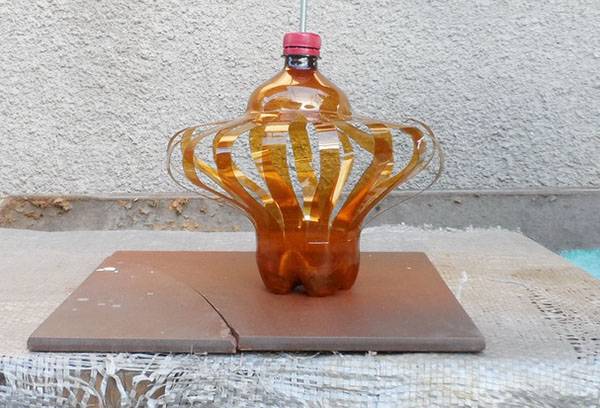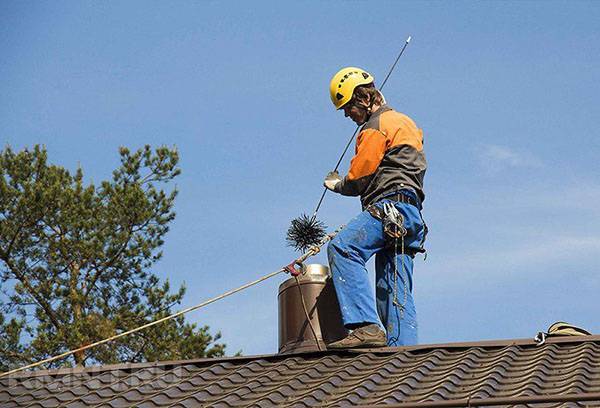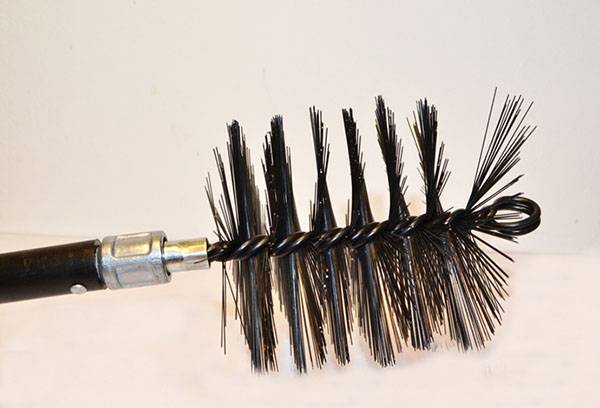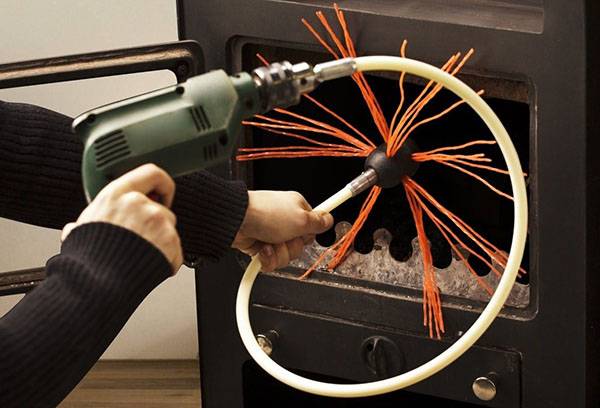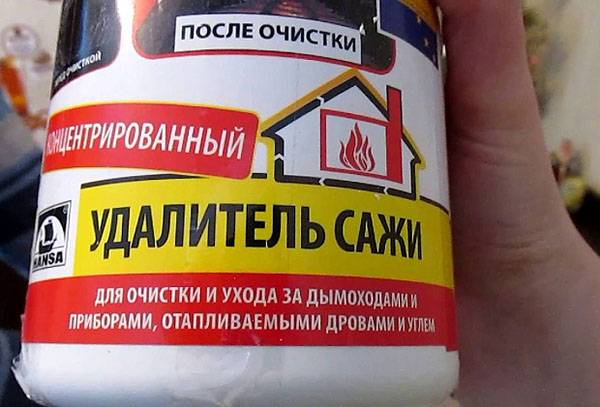Is it possible to clean the chimney without a special ruff and brush?
Content:
Stove heating is required not only for rural residents. If you come to the country in the winter, stoke the stove or fireplace, then the ruff for cleaning the chimney must be in the house. In no case should you leave a pipe clogged with soot if teenagers come to the country house in winter. Schoolchildren may not notice carbon monoxide, fall asleep and poison. Especially dangerous if soot ignites.
How to make a do-it-yourself brush?
The main tool for cleaning the chimney is a brush. What if the pipe is already clogged, you don’t want to go to the city for special devices, and it’s cold in the house? Do not put on 10 fur coats, in less than an hour you will make a brush, clean the chimney and melt the fireplace. Many owners use a brush to make a carbon black remover. To lower it into a pipe, a sinker is often used on a chain, which can be stuck in some branch, sometimes it clings so tightly that you have to disassemble a section of the furnace to extract it. To insure against such a situation, you can attach the brush to the pole and manually push the structure into the chimney.
You can make a simple ruff for cleaning chimneys from plastic bottles. This design quickly deteriorates, but for one cleaning it is enough. The device is fragile, it will help to cope with a little pollution, and to make it is so simple that even a single woman can easily cope with the work.
To make a brush, you will need:
- 2 plastic bottles of 1.5–2 l with caps;
- strong steel cable about a meter longer than the chimney;
- welding electrode or wire with a diameter of 5 mm;
- a weight of about 5 kg.
Cut the walls of the bottles into strips about 15 mm thick; make holes for the wire in the bottoms and caps. Insert one plastic container into another and use the wire as close as possible to the bottom and the lid. From the deformation of the vessels, the strips will diverge to the sides, the bottles will take a shape resembling a yule. Attach a sinker to the lower end of the wire, connect the top to the cable. Check that the load is exactly in the center, and the entire structure hangs smoothly, without distortions. If you have a brush from a grinder of a suitable diameter, it is better to use it instead of bottles - cleaning will become more effective.
Do not forget that the plastic structure is very fragile, it is not designed to remove age-old petrified soot deposits. If the stove was drowned with low-quality combustible materials, the pipe did not clean for a long time and dense deposits of soot appeared in it, a weak brush can not cope with pollution. Have to call for help "heavy artillery": poles, metal brushes.
How to clean the chimney?
Never clean a hot stove. Wait until all the parts have cooled, then remove the pre-laid firewood, unburned remains, and iron parts from the burned wooden structures from the firebox. If you have branded appliances for cleaning stoves, the work will be done much better. A brush made by a specialized company is mounted on a convenient flexible handle. With this device you can get to the farthest and most inaccessible corners and remove soot from there.
To work with homemade brushes, climb onto the roof and securely fasten there. Make sure that the sinker is streamlined and not larger than 2/3 of the diameter of the smoke hole.The first clumsy piece of metal that comes to hand cannot be taken for this purpose: it will firmly get stuck in any crack, and you will have to disassemble the laying of the furnace. Lower the brush down, then lift it up. Make such movements for several minutes until the soot stops falling into the furnace or flying out of the pipe. Open all the doors and the cleaning openings in the chimney and rake the ash, starting from the upper tier and ending with the firebox.
Be sure to carry out such work before each heating season, even if you have not used the stove a single time last year. Not only soot accumulates in the pipe. Any objects that get there can cause a fire or carbon monoxide poisoning.
When cleaning a chimney that has not been used for a long time, there may be:
- fallen leaves;
- web;
- insect nests;
- feathers and remains of birds.
Pipe cleaning is the concern of the landlord
Who are the chimney sweeps, our generation knows only by fairy tales and signs. In the old days, people in this profession were treated with great respect, hitting them by the sleeve was considered a lucky chance. Most likely, having shown some perseverance, you will find a company producing such work, but its services are expensive. Which is better: doing dirty work on your own or giving part of the family budget to hired specialists is up to you.
Engaging in chimney cleaning is not a very pleasant task. Get ready for soot to pour into the oven and scatter around the house. No matter how firmly you close all the doors, you still have to clean the room. Especially difficult with a fireplace. The firebox in it will need to be curtained with wet cloth, but the fabric will not protect from each speck of dust. Things will not be better on the street. Soot will go in clubs from the chimney, and if laundry is drying near the house, it will have to be washed. Try to choose calm weather for work, so as not to quarrel with all the neighbors.
A chimney sweeper needs to take care of his safety. Install a solid staircase, and if the roof is steep and slippery, be sure to attach it to a pipe or other reliable structure. Departing burns can get into the eyes and the respiratory tract - wear a respirator and safety glasses. Do not grab the metal cable with your bare hands, protect your palms with work gloves.
Where to buy equipment for the care of stoves and fireplaces?
For several years you gathered in the country, basked by the fireplace, but suddenly noticed that the smoke no longer goes into the chimney, but fills the room. The whole company begins to cough, wipe away tears. The landlord is to blame for this situation: pipes must be monitored. If a lot of soot has accumulated in the chimney, carbon monoxide can poison all people in the room, and unburned residues sometimes ignite and provoke a fire. For prevention, clean the smoke exhaust system before each heating season.
Tip
Smoke can go into the room even with a clean chimney. If the stove has cooled to an ice state, and on the street it is warmer than in the house, the pipe will not work. To avoid carbon monoxide poisoning, open the shutter in advance. After about half an hour, put in a hole leading into the pipe, a large lump of paper and set fire, at the same time flood the stove. The smoke from the newspapers will go outside, draw the air from the burning of firewood, and all the gas will go into the chimney.
Do not think that cleaning the pipe is a difficult task, accessible only to specialists. Cleaning the chimney will not take more than 20 minutes if you have the right tool at hand. For work you will need:
- good brush;
- strong wire;
- rope;
- sinker.
If you want to use high-quality equipment, you can search for it in household departments or online stores. Trading companies offer both individual appliances and complete sets for the care of heating appliances. VORTEX company makes all kinds of brushes and ruffs for cleaning pipes of any diameter. A set costs about 2000 rubles, individual instruments can be found at a lower price.If you do not want to pay for a convenient tool, do it yourself.
Chimney Prevention
It is impossible to completely rid yourself of pipe cleaning, but you can facilitate this work. Do not forget that the home stove is not an incinerator, all waste should not be thrown into it. Polymer products are specifically prohibited. Not only do they emit toxic smoke, but ash cannot be used to fertilize the garden. Particles of film and plastic settle on the walls of the pipe and create a solid connection, which is very difficult to knock down. Send household garbage to a landfill or incinerate somewhere in a wasteland.
When harvesting firewood, try not to use resinous coniferous wood. Heavy residues of sticky juice cannot fly high up and settle in the chimney. Least soot give birch and aspen logs, rural residents often use them to clean pipes. When firing, you can throw a little salt or half a bucket of dry potato peelings on the chocks - when burned, they soften soot deposits, it either falls down itself or is easily cleaned with a brush.
Chemicals for cleaning chimneys are on sale. If you want to use them, carefully read the instructions and follow all safety precautions. The effectiveness of these funds is low, and they give a lot of harmful fumes. Such cleaning products are indispensable if the owners managed to clog the pipe so with dense layers of soot that it is simply impossible to break through them mechanically. If you have had such a nuisance, get “Kominichke” or “Log-chimney sweep”, soften the soot, and then remove it with a brush.
Cleanliness must be observed not only in rooms or on the site. A chimney clogged with fumes is no less harmful to health than house dust. If you have a house or a cottage with stove heating, be sure to have at hand all the necessary equipment for cleaning pipes. Do not want to mess with soot yourself - contact a special service, professionals will do the job quickly and efficiently. Use any option, but do not heat stoves with uncleaned pipes if you do not want to poison the whole family with carbon monoxide.
